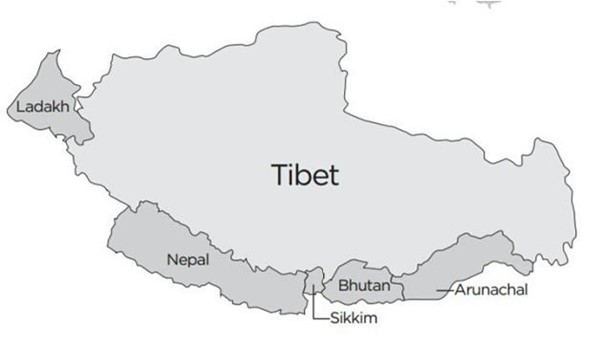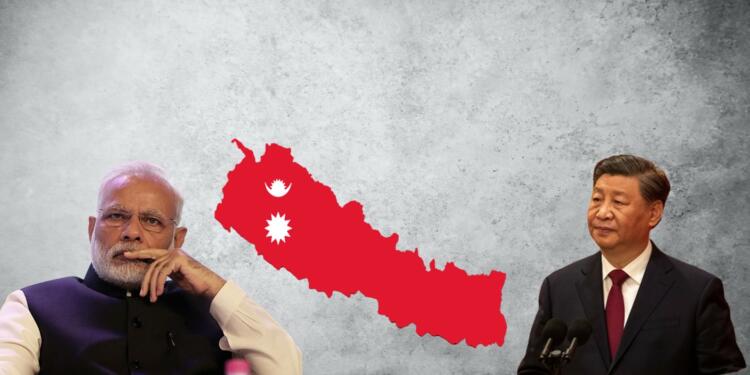If anyone has spent even half an hour studying China, they won’t be surprised by what China is doing to its neighbours. China is a country which has very little resources. Land mass of the country is one of the worst in the world. To feed its population, the Communist nation uses agrochemicals in huge amounts.
Most of them are imported. Regarding chemicals like Lithium, cobalt, nickel and many others, it has to depend on Africa and Latin America. The moment these supplies are gone, we are looking at the China of the pre-Deng Xiaoping era. Heck, they do not have the intellectual capability to operate technology that they stole from others in intellectual theft.
In those circumstances, the only option left for it is looking towards its neighbours. Even there, the Chinese do not have many options. For instance, they once visited Vietnam in 1979 and the Vietnamese welcome gesture to them was as good as it was to Americans. With the misadventures in the South China sea, China has further alienated Philippines, Indonesia, Malaysia, Brunei, Taiwan.
This further reduces their chances of being successful in conflict with Japan. Additionally, it is due to China’s threat that Japan is re-militarising. That left China with Pakistan, Nepal and India. Now, India already shares a stressful tie with Mao’s nation. To control India, China has to get Pakistan and Nepal on its side. Pakistan is theirs, no matter how bad it is. Nepal is their final frontier. And that is why it becomes imminent for India to save Himalayan nation from dragon’s clutches.
Prachanda and China
It is not a hidden fact that Push Kamal Dahal Prachand, the current Prime Minister of Nepal is a fan of China. I mean, the guy has treated Mao Zedong as ideal for whole life. When he had started an insurgency, he wanted to bring Communism to China. In fact, one of his demands was to do away with the 1950 treaty of peace and friendship with Nepal.
There is no reason to assume that he would be pro-India even if he has left his violent tactics. In fact, both Prachand and China share mutual admiration for each-other. Reasons? Maybe both have the same authoritarians’ genes.
Prachanda came to power on 26th December 2022. Very next day, the acting Chinese ambassador gave him a congratulatory gesture. As a gift, the ambassador conveyed to Prachanda that Nepal-China border checkpoints on Rasuwa, Kerung and Hilsa have been opened after 35 months of Covid-19 related locks. Within days, Prachanda inaugurated an international airport in Pokhara.
It is only the 3rd of its kind in Nepal and has been built with $251.96 million of Chinese money. China also announced that it wants to accelerate the development of projects related to its Belt and Road initiative in the Himalayan nation.
China’s advent in Nepal
If you come to think of this as an aberration and special gesture towards Prachand, you are wrong. China is one of the largest investors in Nepal, with Chinese companies investing heavily in infrastructure projects such as hydropower, roads, and airports.
These include construction of the Pokhara International Airport, the Kathmandu Ring Road, and the Belt and Road Initiative-linked Trans-Himalayan Multi-Dimensional Connectivity Network. Between 2015 and 2021, China remained the largest source of FDI investment for Nepal.
More than investment amount, the places where China is choosing to put its money in Nepal is more concerning. For instance, Trans-Himalayan Multi-Dimensional Connectivity Network involves a cross-border railway connecting China’s Tibet Autonomous Region with Kathmandu. If you analyse it from the historical perspective, China’s intention could not be more clear.

PC: Studyiq
Nepal’s importance for China and five-finger strategy
Chinese investment is aimed towards its five-finger strategy. It was coined by Mao. Chinese treat Ladakh, Nepal, Bhutan, Sikkim and Arunachal Pradesh as five fingers while Tibet is treated as its palm.
The Chinese have always wished to get these regions under its control. By doing that, they would get a grip on any geographical roadblocks coming in the way of their aggressive overture towards India, their biggest contestant for supremacy in the Asian continent.
That is why you keep seeing news of Chinese trying to invoke tensions on the border, especially along the lines of its Line of Actual Control on Sikkim, Arunachal Pradesh and Ladakh. The problem with that strategy is that in recent years, India has been meeting fire with fire, or should I say their martial arts with vicious Indian punches.
Additionally, India has started laying out infrastructure along LAC in an unprecedented way. This is going to further aid the already oft-spoken northeast states with the rest of India.
Nepal-China security cooperation
Being devoid of any relief from insurgent groups in Indian states, that again leaves China with only Bhutan and Nepal. With Bhutan, they are trying to make it big, but with Nepal, they have already done it.
Their overture towards Nepal has expanded to the security domain as well. After India’s INSAS Rifle turned out to be out of date for Nepalese Armed Forces in 2005, Nepalese Army started to hunt for M4s, M16s and other NATO rifles. It was China which jumped in to occupy the place held by India. It took 8 years for an Indian company to break this monopoly.
Despite that, it is like a penny in a sea of millions of Dollars given by the Chinese to the Nepal military. In 2019, China gave Rs 2.5 billion in military aid to Nepal. China also provides military hardware to Nepal and has promised to enhance the capabilities of Nepalese law-enforcement agencies, police forces, intelligence agencies and border management organisations among others.
Both countries also conduct a joint military deal. No points for guessing who benefits more from these drills. Chinese get access to key chinks in armour of Nepalese Army and use that to enhance its Security diplomacy by promising to fill the gaps.
China developing cultural bonds with Nepal
Despite all of this, the biggest problem for Chinese in cutting down Nepal’s bonhomie with India is their cultural relations with Bharatvarsh. Nepal and Indian states of Uttar Pradesh and Bihar are highly interlinked, so much so that borders are open.
International marriages between citizens of both countries are commonplace, relatives stay across the borders. Indian currency works there. Whenever fuel prices go up in India, people living in border areas cross the border to buy cheaper fuel from Nepal. Madhesis in Nepal and Indians along the Nepal border even speak the same language.
All of this may be diluted if the Indian government does not wake up quickly. The Chinese are building their cultural relations with Nepal very very quickly. It first gained emphatic points by points by rushing in $500 million and 62-person team.
Seeing strong support for India on ground, Chinese have been pushing more and more aggressively. Advent of Chinese tourists in Nepal has increased at a staggering pace. In 2019, they comprised more than 14 per cent of total tourists filling the coffers of the land-locked country with Forex Reserves.
When Jinping visited Nepal in 2019, Nepali Congress party distributed copies of Jinping’s philosophy to its members. On a more grassroot level, China is also promoting Mandarin in the schools of Nepal. It also gives scholarships to 100 Nepali students to study in China. These are clear cut attempts to eliminate India’s cultural influence from the psyche of Nepali people. By promoting Mandarin, Chinese are trying to replace Hindi as a language of second choice and by giving them scholarships in their own universities, China is trying to cut-short the influence of India on future Nepali children.
In addition to that, friendly visits, cultural festivals, film shows, food festivals, sister city connections between China and Nepal have also seen burgeoning rise in the last few years.
Nepal’s importance for India
The threat to India is bigger than ever. India shares Beti-Roti bonds with Nepal. Traditionally, both countries have a shared bonhomie. Both countries have interconnected rivers. Total 5 river basins originate from Nepal and feed India’s river system. Tourists’ exchange for religious purposes is such a prevalent phenomenon that people don’t even discuss it. India and Nepal have 3 sister city engagements in the form of Kathmandu-Varanasi, Lumbini-Bodhgaya and Janakpur-Ayodhya.
Situated on India’s “Himalayan frontiers,” Nepal, along with Bhutan, serves as a buffer state against potential aggression from China and acts as a northern borderland.
Read more: Communists hand over Nepal to China
The open border signifies how much India has been trustful of Nepal as a whole. But, somehow,Nepal has not been able to uphold the full spirit due to its own inherent weakness. Traditionally, Nepal has been used by anti-India forces to weaken India. These are mainly the terrorist ones having their origin in Pakistan.
They use the Himalayan nation as a transit geography towards India. They run stuff like illegal notes racket and money laundering, use safe havens in Nepal for securing their arms, and come to Indian territory by taking advantage of the open border with Nepal. There are chances of Nepal making it to the grey list of FATF due to these reasons.
One last push is needed
Even grey listing would not result in an advantage for India. Simply because Nepal is largely under China’s influence. It is advantageous for China if more and more terrorists use Nepal for spreading ruckus in India. One reason why China caught hold of Pakistan was to enhance Pakistan’s ability in their attempt to bleed India with 1000 cuts. Now that Pakistan is itself bleeding, thanks to the Frankenstein monster called Tehrik-i-Taliban, Nepal’s importance for China has grown further.
Read more: Bangladesh hasn’t learned the China lesson from Nepal and Sri Lanka
Nepal is too important for India to let go. Most of the Chinese influence in its neighbours is dying. They are not that influential in Sri Lanka, or for that matter even Pakistan, as the country itself is on the verge of destruction. Weeding China out of Nepal can keep us in peace for decades to come. If needed, we could also nudge the US and QUAD by presenting the security of Nepal as key for throwing out Chinese influence from the Indo-Pacific.
Support TFI:
Support us to strengthen the ‘Right’ ideology of cultural nationalism by purchasing the best quality garments from TFI-STORE.COM































